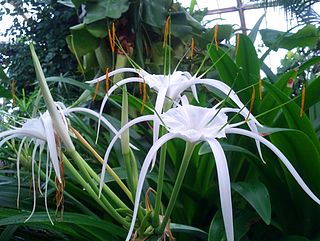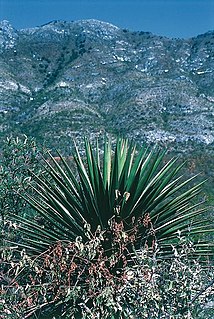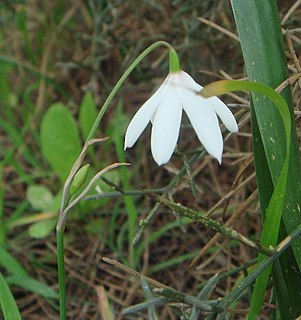
Dasylirion wheeleri is a species of flowering plant in the asparagus family Asparagaceae, native to arid environments of northern Mexico, in Chihuahua and Sonora and in the southwestern United States, in the Sonoran Desert in Arizona, and also in New Mexico and Texas.

Hymenocallis (US) or (UK) is a genus of American plants in the amaryllis family.

Haemanthus albiflos is a species of flowering plant in the family Amaryllidaceae, native to South Africa. It is sometimes given the English name paintbrush, not to be confused with Castilleja species which also have this name. It is an evergreen bulbous perennial geophyte, prized horticulturally for its unusual appearance and extreme tolerance of neglect. H. albiflos is the only Haemanthus species found in both winter and summer rainfall regions, and has a mainly coastal distribution from the southern Cape through the Eastern Cape to KwaZulu-Natal, showing a preference for cool, shady spots.

Eustrephus is a monotypic genus in the family Asparagaceae, subfamily Lomandroideae.

Hymenocallis littoralis or the beach spider lily is a plant species of the genus Hymenocallis, native to warmer coastal regions of Latin America and widely cultivated and naturalized in many tropical countries.

Agave shrevei is a member of the family Asparagaceae, indigenous to the Sierra Madre Occidental in Mexico, along the boundary between the states of Chihuahua and Sonora. Two subspecies are currently recognized, although a third has been proposed.

Hymenocallis pimana is a member of the genus Hymenocallis, in the family Amaryllidaceae. Common name in English is Pima spider-lily; in Spanish it is cebollín. It is endemic to a small mountainous region in the Sierra Madre Occidental, straddling the Mexican states of Chihuahua and Sonora. Many of the people of the region are of the indigenous group known as the Mountain Pima or Pima Bajo.

Yucca declinata is a species of the genus Yucca, family Asparagaceae. It is known only from the vicinity of Bacanora, in the Mexican state of Sonora. Botanist Howard Scott Gentry first collected the species and mentioned it in print, noting the differences between this population and the closely related species Y. grandiflora H. S. Gentry and Y. arizonica McKelvey. He did not, however, describe it as a new species. Later examination of his descriptions and his material led to the recognition of this as a new species.

Passiflora bryonioides, the cupped passionflower, is a plant in the genus Passiflora, family Passifloraceae. It is native to northern Mexico and the south-western United States (Arizona).
Hymenocallis sonorensis is a species of plant in the family Amaryllidaceae, known from several locations in the southern part of the Mexican State of Sonora, as well as the neighboring States of Sinaloa and Nayarit.
Prionosciadium saraviki, common name saraviki, is a plant species in the genus Prionosciadium, in the carrot family, Apiaceae. It is known only from a mountainous region of the Sierra Madre Occidental in the Mexican State of Chihuahua. Type locale is the village of Nabogame, approximately 18 km northwest of Yepachic, Chihuahua, 10 km east of the border with Sonora. The plant grows there mostly along creekbanks and near springs.

Yepáchic, sometimes spelled Yepáchi, is a community in the western part of the Mexican State of Chihuahua, approximately 10 km (6.2 mi) east of the boundary with the State of Sonora. It is located in the Municipio de Temósachic at an altitude of 1,780 meters (5,840 ft) in the Sierra Madre Occidental. Many of the people of the region are members of the indigenous ethnic group called Mountain Pima or the Pima Bajo. They are related to the Pima and Papago of Arizona and northern Sonora, speaking a similar but distinct language.

Hymenocallis occidentalis is a plant species native to the southern United States. It is known along the Gulf Coast from South Carolina to Texas, and in the Mississippi Valley as far north as southern Illinois and Indiana. It is also cultivated as an ornamental elsewhere because of its showy, sweet-smelling flowers. Common names include woodland spider-lily, hammock spider-lily or northern spider-lily.
Hymenocallis tridentata, the Florida spider-lily, is a bulb-forming herb native to southern Florida, to about as far north as Vero Beach. The species grows in marshes and wet prairies very close to sea level. It is similar to H. rotata, but somewhat smaller.
Hymenocallis duvalensis is a plant species in the genus Hymenocallis, family Amaryllidaceae. It is a bulb-forming herb with showy white flowers, native to floodplains and streambanks in Florida and Georgia.
Hymenocallis durangoensis is a plant species endemic to the Mexican state of Durango. It is a bulb-forming herb with white flowers.

Berberis haematocarpa, Woot. with the common names red barberry, red Mexican barbery, Colorado barberry and Mexican barberry, is a species in the Barberry family in southwestern North America. It is also sometimes called algerita, but that name is more often applied to its relative, Mahonia trifoliolata.

Hannonia is a genus of plants in the Amaryllis family. It contains only one known species, Hannonia hesperidum, endemic to Morocco and confined to Western Morocco, Promontory of Hercules. The specific name comes from Greek έσπερος, of evening, as the flowers open in the late afternoon.
Joseph Edward Laferrière is an American botanist with a particular interest in ethnobotany.

Acis trichophylla is a species of flowering plant in the family Amaryllidaceae, native to Portugal, Spain and Morocco. It has very narrow leaves. The flowers are produced in late winter or early spring and are usually white, but sometimes pink-tinged or all pink. The species is cultivated as an ornamental bulb, but requires protection from hard frost.













